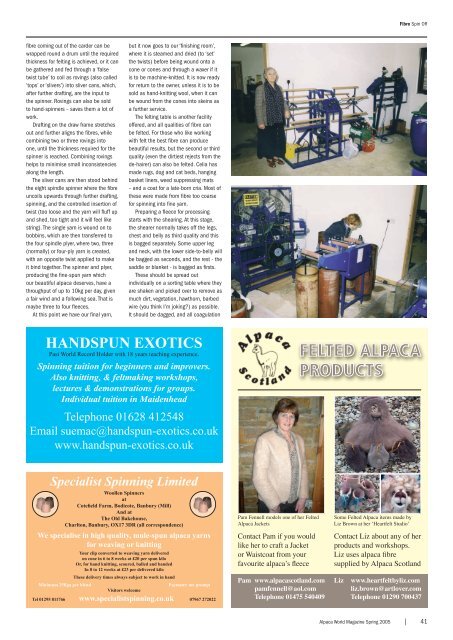Alpaca World Magazine Spring 2005 - Classical MileEnd Alpacas
Alpaca World Magazine Spring 2005 - Classical MileEnd Alpacas
Alpaca World Magazine Spring 2005 - Classical MileEnd Alpacas
You also want an ePaper? Increase the reach of your titles
YUMPU automatically turns print PDFs into web optimized ePapers that Google loves.
Fibre Spin Off<br />
fi bre coming out of the carder can be<br />
wrapped round a drum until the required<br />
thickness for felting is achieved, or it can<br />
be gathered and fed through a ‘false<br />
twist tube’ to coil as rovings (also called<br />
‘tops’ or ‘slivers’) into sliver cans, which,<br />
after further drafting, are the input to<br />
the spinner. Rovings can also be sold<br />
to hand-spinners – saves them a lot of<br />
work.<br />
Drafting on the draw frame stretches<br />
out and further aligns the fi bres, while<br />
combining two or three rovings into<br />
one, until the thickness required for the<br />
spinner is reached. Combining rovings<br />
helps to minimise small inconsistencies<br />
along the length.<br />
The sliver cans are then stood behind<br />
the eight spindle spinner where the fi bre<br />
uncoils upwards through further drafting,<br />
spinning, and the controlled insertion of<br />
twist (too loose and the yarn will fl uff up<br />
and shed, too tight and it will feel like<br />
string). The single yarn is wound on to<br />
bobbins, which are then transferred to<br />
the four spindle plyer, where two, three<br />
(normally) or four-ply yarn is created,<br />
with an opposite twist applied to make<br />
it bind together. The spinner and plyer,<br />
producing the fi ne-spun yarn which<br />
our beautiful alpaca deserves, have a<br />
throughput of up to 10kg per day, given<br />
a fair wind and a following sea. That is<br />
maybe three to four fl eeces.<br />
At this point we have our fi nal yarn,<br />
but it now goes to our ‘fi nishing room’,<br />
where it is steamed and dried (to ‘set’<br />
the twists) before being wound onto a<br />
cone or cones and through a waxer if it<br />
is to be machine-knitted. It is now ready<br />
for return to the owner, unless it is to be<br />
sold as hand-knitting wool, when it can<br />
be wound from the cones into skeins as<br />
a further service.<br />
The felting table is another facility<br />
offered, and all qualities of fi bre can<br />
be felted. For those who like working<br />
with felt the best fi bre can produce<br />
beautiful results, but the second or third<br />
quality (even the dirtiest rejects from the<br />
de-hairer) can also be felted. Celia has<br />
made rugs, dog and cat beds, hanging<br />
basket liners, weed suppressing mats<br />
– and a coat for a late-born cria. Most of<br />
these were made from fi bre too coarse<br />
for spinning into fi ne yarn.<br />
Preparing a fl eece for processing<br />
starts with the shearing. At this stage,<br />
the shearer normally takes off the legs,<br />
chest and belly as third quality and this<br />
is bagged separately. Some upper leg<br />
and neck, with the lower side-to-belly will<br />
be bagged as seconds, and the rest - the<br />
saddle or blanket - is bagged as fi rsts.<br />
These should be spread out<br />
individually on a sorting table where they<br />
are shaken and picked over to remove as<br />
much dirt, vegetation, hawthorn, barbed<br />
wire (you think I’m joking?) as possible.<br />
It should be dagged, and all coagulation<br />
<strong>Alpaca</strong> <strong>World</strong> <strong>Magazine</strong> <strong>Spring</strong> <strong>2005</strong> | 41







